Air Pollution & Health: Silica Dust Effects - [University Name] Report
VerifiedAdded on 2023/06/12
|6
|1547
|471
Report
AI Summary
This report examines the properties of silica dust and its detrimental effects on human health, particularly for workers exposed in construction and mining environments. It details the risks of silicosis, lung cancer, and other respiratory diseases associated with silica inhalation. The report further investigates the limitations of current precautionary measures and the potential for worker exposure even with safety protocols in place. It also outlines available treatments for silicosis, including symptom management and lung transplants, while acknowledging the challenges in affordability and success rates. The report emphasizes the importance of workplace safety regulations and proactive health monitoring to mitigate the risks associated with silica dust exposure. Desklib offers this document along with a wealth of resources like past papers and solved assignments for students.
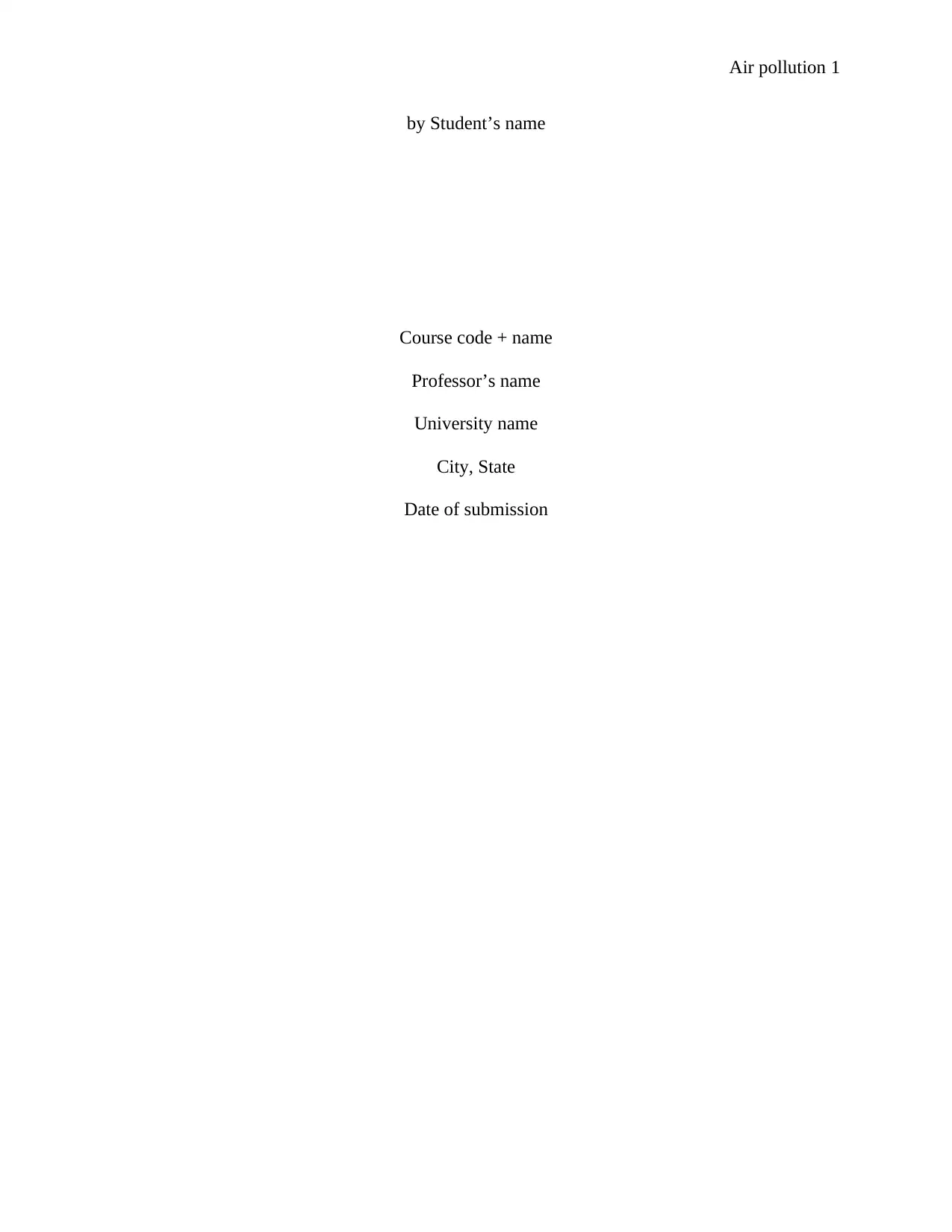
Air pollution 1
by Student’s name
Course code + name
Professor’s name
University name
City, State
Date of submission
by Student’s name
Course code + name
Professor’s name
University name
City, State
Date of submission
Paraphrase This Document
Need a fresh take? Get an instant paraphrase of this document with our AI Paraphraser
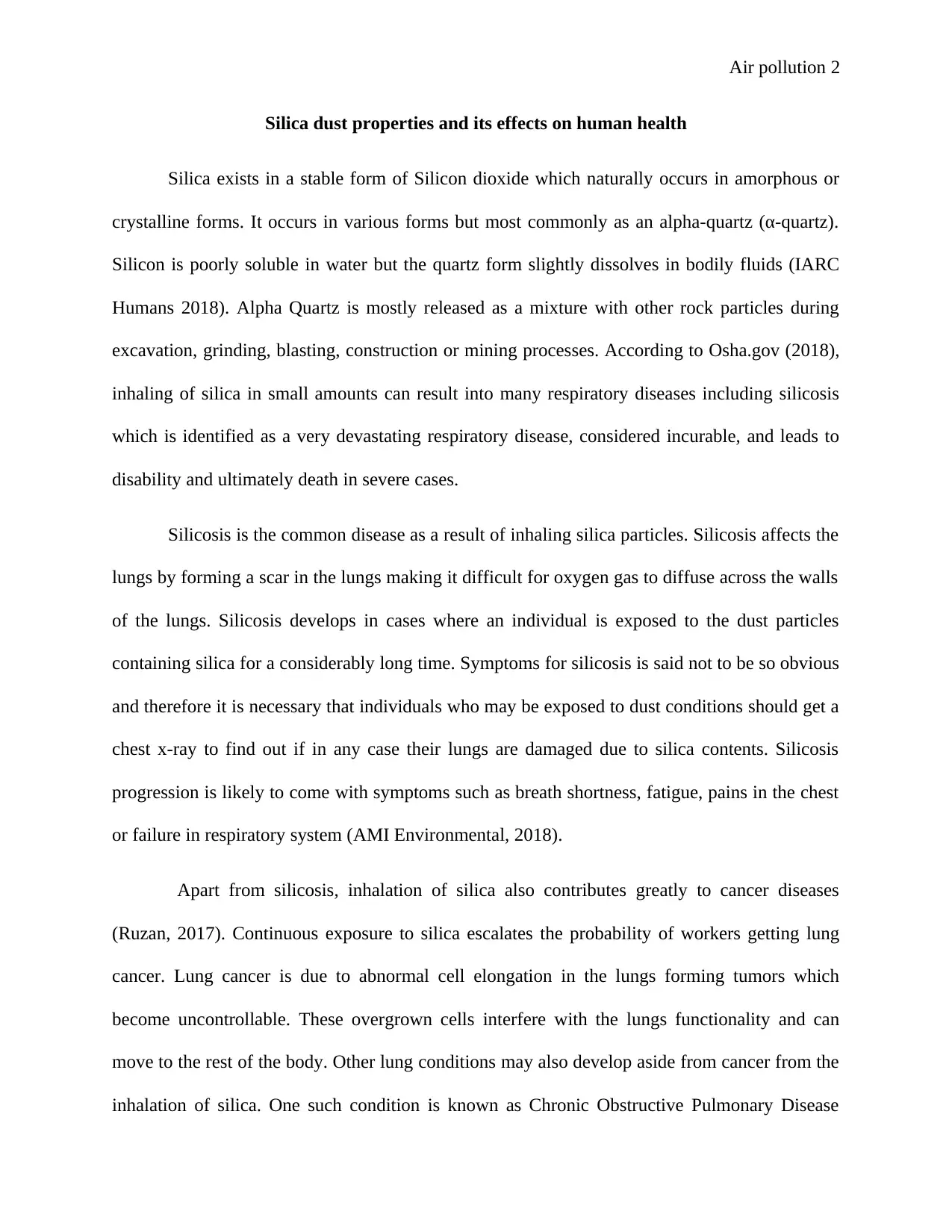
Air pollution 2
Silica dust properties and its effects on human health
Silica exists in a stable form of Silicon dioxide which naturally occurs in amorphous or
crystalline forms. It occurs in various forms but most commonly as an alpha-quartz (α-quartz).
Silicon is poorly soluble in water but the quartz form slightly dissolves in bodily fluids (IARC
Humans 2018). Alpha Quartz is mostly released as a mixture with other rock particles during
excavation, grinding, blasting, construction or mining processes. According to Osha.gov (2018),
inhaling of silica in small amounts can result into many respiratory diseases including silicosis
which is identified as a very devastating respiratory disease, considered incurable, and leads to
disability and ultimately death in severe cases.
Silicosis is the common disease as a result of inhaling silica particles. Silicosis affects the
lungs by forming a scar in the lungs making it difficult for oxygen gas to diffuse across the walls
of the lungs. Silicosis develops in cases where an individual is exposed to the dust particles
containing silica for a considerably long time. Symptoms for silicosis is said not to be so obvious
and therefore it is necessary that individuals who may be exposed to dust conditions should get a
chest x-ray to find out if in any case their lungs are damaged due to silica contents. Silicosis
progression is likely to come with symptoms such as breath shortness, fatigue, pains in the chest
or failure in respiratory system (AMI Environmental, 2018).
Apart from silicosis, inhalation of silica also contributes greatly to cancer diseases
(Ruzan, 2017). Continuous exposure to silica escalates the probability of workers getting lung
cancer. Lung cancer is due to abnormal cell elongation in the lungs forming tumors which
become uncontrollable. These overgrown cells interfere with the lungs functionality and can
move to the rest of the body. Other lung conditions may also develop aside from cancer from the
inhalation of silica. One such condition is known as Chronic Obstructive Pulmonary Disease
Silica dust properties and its effects on human health
Silica exists in a stable form of Silicon dioxide which naturally occurs in amorphous or
crystalline forms. It occurs in various forms but most commonly as an alpha-quartz (α-quartz).
Silicon is poorly soluble in water but the quartz form slightly dissolves in bodily fluids (IARC
Humans 2018). Alpha Quartz is mostly released as a mixture with other rock particles during
excavation, grinding, blasting, construction or mining processes. According to Osha.gov (2018),
inhaling of silica in small amounts can result into many respiratory diseases including silicosis
which is identified as a very devastating respiratory disease, considered incurable, and leads to
disability and ultimately death in severe cases.
Silicosis is the common disease as a result of inhaling silica particles. Silicosis affects the
lungs by forming a scar in the lungs making it difficult for oxygen gas to diffuse across the walls
of the lungs. Silicosis develops in cases where an individual is exposed to the dust particles
containing silica for a considerably long time. Symptoms for silicosis is said not to be so obvious
and therefore it is necessary that individuals who may be exposed to dust conditions should get a
chest x-ray to find out if in any case their lungs are damaged due to silica contents. Silicosis
progression is likely to come with symptoms such as breath shortness, fatigue, pains in the chest
or failure in respiratory system (AMI Environmental, 2018).
Apart from silicosis, inhalation of silica also contributes greatly to cancer diseases
(Ruzan, 2017). Continuous exposure to silica escalates the probability of workers getting lung
cancer. Lung cancer is due to abnormal cell elongation in the lungs forming tumors which
become uncontrollable. These overgrown cells interfere with the lungs functionality and can
move to the rest of the body. Other lung conditions may also develop aside from cancer from the
inhalation of silica. One such condition is known as Chronic Obstructive Pulmonary Disease
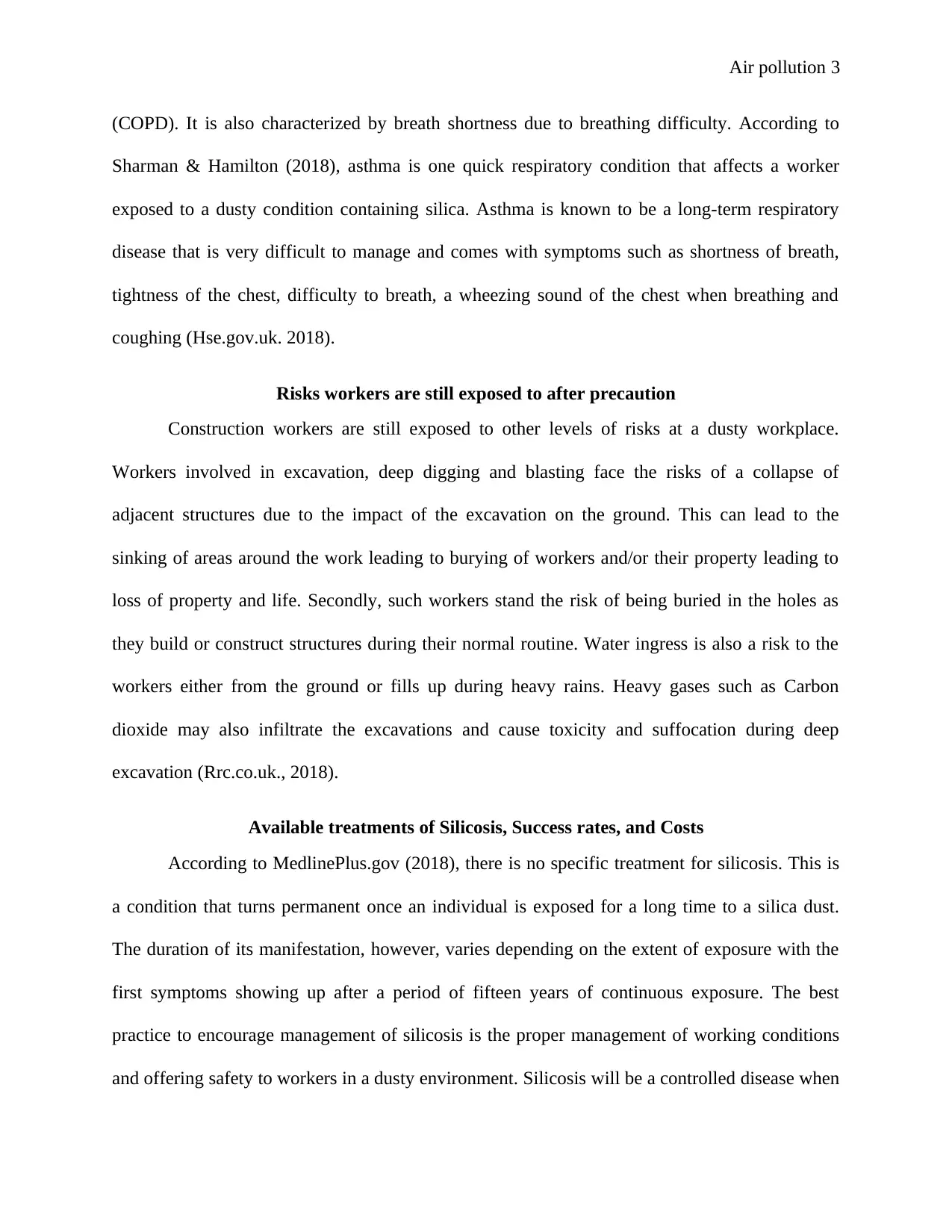
Air pollution 3
(COPD). It is also characterized by breath shortness due to breathing difficulty. According to
Sharman & Hamilton (2018), asthma is one quick respiratory condition that affects a worker
exposed to a dusty condition containing silica. Asthma is known to be a long-term respiratory
disease that is very difficult to manage and comes with symptoms such as shortness of breath,
tightness of the chest, difficulty to breath, a wheezing sound of the chest when breathing and
coughing (Hse.gov.uk. 2018).
Risks workers are still exposed to after precaution
Construction workers are still exposed to other levels of risks at a dusty workplace.
Workers involved in excavation, deep digging and blasting face the risks of a collapse of
adjacent structures due to the impact of the excavation on the ground. This can lead to the
sinking of areas around the work leading to burying of workers and/or their property leading to
loss of property and life. Secondly, such workers stand the risk of being buried in the holes as
they build or construct structures during their normal routine. Water ingress is also a risk to the
workers either from the ground or fills up during heavy rains. Heavy gases such as Carbon
dioxide may also infiltrate the excavations and cause toxicity and suffocation during deep
excavation (Rrc.co.uk., 2018).
Available treatments of Silicosis, Success rates, and Costs
According to MedlinePlus.gov (2018), there is no specific treatment for silicosis. This is
a condition that turns permanent once an individual is exposed for a long time to a silica dust.
The duration of its manifestation, however, varies depending on the extent of exposure with the
first symptoms showing up after a period of fifteen years of continuous exposure. The best
practice to encourage management of silicosis is the proper management of working conditions
and offering safety to workers in a dusty environment. Silicosis will be a controlled disease when
(COPD). It is also characterized by breath shortness due to breathing difficulty. According to
Sharman & Hamilton (2018), asthma is one quick respiratory condition that affects a worker
exposed to a dusty condition containing silica. Asthma is known to be a long-term respiratory
disease that is very difficult to manage and comes with symptoms such as shortness of breath,
tightness of the chest, difficulty to breath, a wheezing sound of the chest when breathing and
coughing (Hse.gov.uk. 2018).
Risks workers are still exposed to after precaution
Construction workers are still exposed to other levels of risks at a dusty workplace.
Workers involved in excavation, deep digging and blasting face the risks of a collapse of
adjacent structures due to the impact of the excavation on the ground. This can lead to the
sinking of areas around the work leading to burying of workers and/or their property leading to
loss of property and life. Secondly, such workers stand the risk of being buried in the holes as
they build or construct structures during their normal routine. Water ingress is also a risk to the
workers either from the ground or fills up during heavy rains. Heavy gases such as Carbon
dioxide may also infiltrate the excavations and cause toxicity and suffocation during deep
excavation (Rrc.co.uk., 2018).
Available treatments of Silicosis, Success rates, and Costs
According to MedlinePlus.gov (2018), there is no specific treatment for silicosis. This is
a condition that turns permanent once an individual is exposed for a long time to a silica dust.
The duration of its manifestation, however, varies depending on the extent of exposure with the
first symptoms showing up after a period of fifteen years of continuous exposure. The best
practice to encourage management of silicosis is the proper management of working conditions
and offering safety to workers in a dusty environment. Silicosis will be a controlled disease when
⊘ This is a preview!⊘
Do you want full access?
Subscribe today to unlock all pages.

Trusted by 1+ million students worldwide
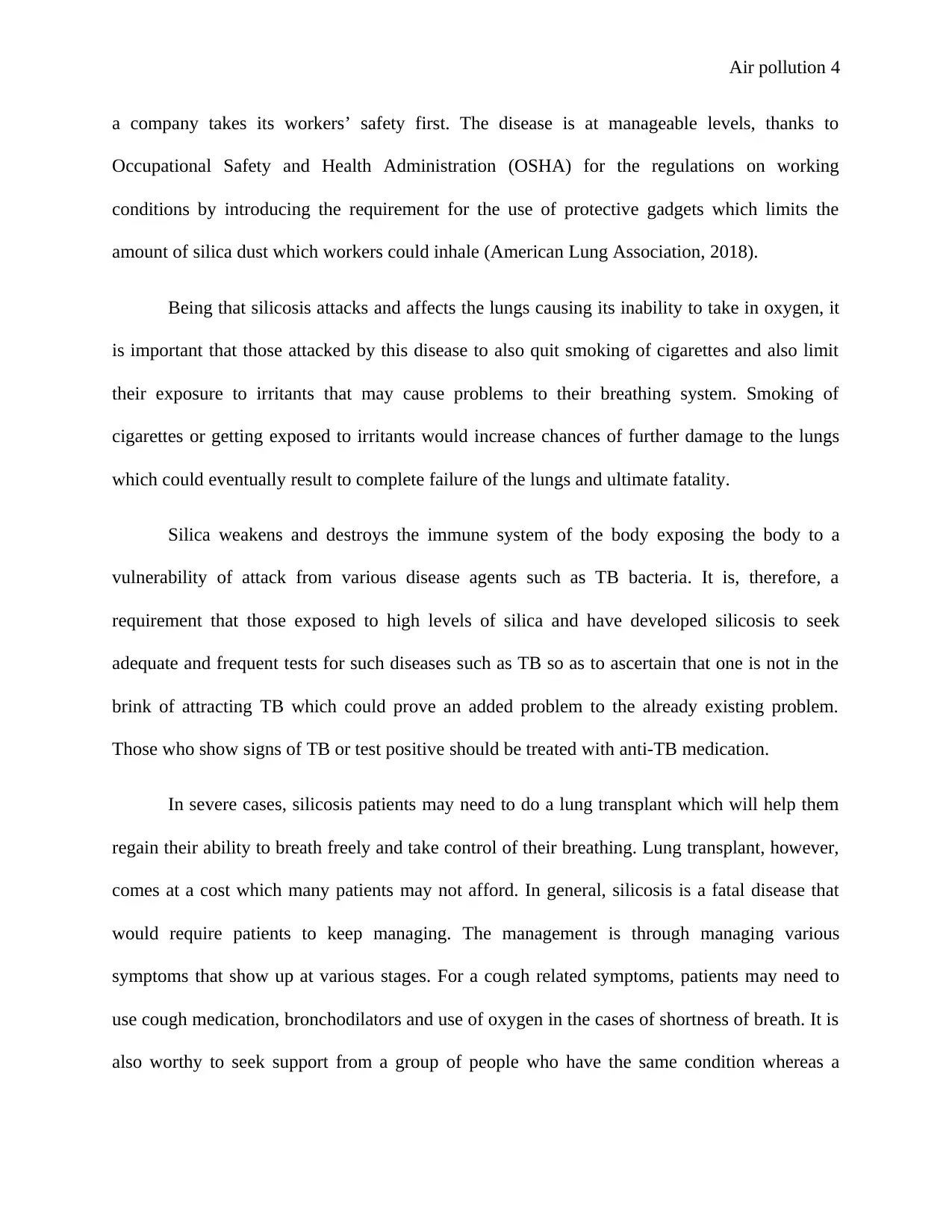
Air pollution 4
a company takes its workers’ safety first. The disease is at manageable levels, thanks to
Occupational Safety and Health Administration (OSHA) for the regulations on working
conditions by introducing the requirement for the use of protective gadgets which limits the
amount of silica dust which workers could inhale (American Lung Association, 2018).
Being that silicosis attacks and affects the lungs causing its inability to take in oxygen, it
is important that those attacked by this disease to also quit smoking of cigarettes and also limit
their exposure to irritants that may cause problems to their breathing system. Smoking of
cigarettes or getting exposed to irritants would increase chances of further damage to the lungs
which could eventually result to complete failure of the lungs and ultimate fatality.
Silica weakens and destroys the immune system of the body exposing the body to a
vulnerability of attack from various disease agents such as TB bacteria. It is, therefore, a
requirement that those exposed to high levels of silica and have developed silicosis to seek
adequate and frequent tests for such diseases such as TB so as to ascertain that one is not in the
brink of attracting TB which could prove an added problem to the already existing problem.
Those who show signs of TB or test positive should be treated with anti-TB medication.
In severe cases, silicosis patients may need to do a lung transplant which will help them
regain their ability to breath freely and take control of their breathing. Lung transplant, however,
comes at a cost which many patients may not afford. In general, silicosis is a fatal disease that
would require patients to keep managing. The management is through managing various
symptoms that show up at various stages. For a cough related symptoms, patients may need to
use cough medication, bronchodilators and use of oxygen in the cases of shortness of breath. It is
also worthy to seek support from a group of people who have the same condition whereas a
a company takes its workers’ safety first. The disease is at manageable levels, thanks to
Occupational Safety and Health Administration (OSHA) for the regulations on working
conditions by introducing the requirement for the use of protective gadgets which limits the
amount of silica dust which workers could inhale (American Lung Association, 2018).
Being that silicosis attacks and affects the lungs causing its inability to take in oxygen, it
is important that those attacked by this disease to also quit smoking of cigarettes and also limit
their exposure to irritants that may cause problems to their breathing system. Smoking of
cigarettes or getting exposed to irritants would increase chances of further damage to the lungs
which could eventually result to complete failure of the lungs and ultimate fatality.
Silica weakens and destroys the immune system of the body exposing the body to a
vulnerability of attack from various disease agents such as TB bacteria. It is, therefore, a
requirement that those exposed to high levels of silica and have developed silicosis to seek
adequate and frequent tests for such diseases such as TB so as to ascertain that one is not in the
brink of attracting TB which could prove an added problem to the already existing problem.
Those who show signs of TB or test positive should be treated with anti-TB medication.
In severe cases, silicosis patients may need to do a lung transplant which will help them
regain their ability to breath freely and take control of their breathing. Lung transplant, however,
comes at a cost which many patients may not afford. In general, silicosis is a fatal disease that
would require patients to keep managing. The management is through managing various
symptoms that show up at various stages. For a cough related symptoms, patients may need to
use cough medication, bronchodilators and use of oxygen in the cases of shortness of breath. It is
also worthy to seek support from a group of people who have the same condition whereas a
Paraphrase This Document
Need a fresh take? Get an instant paraphrase of this document with our AI Paraphraser
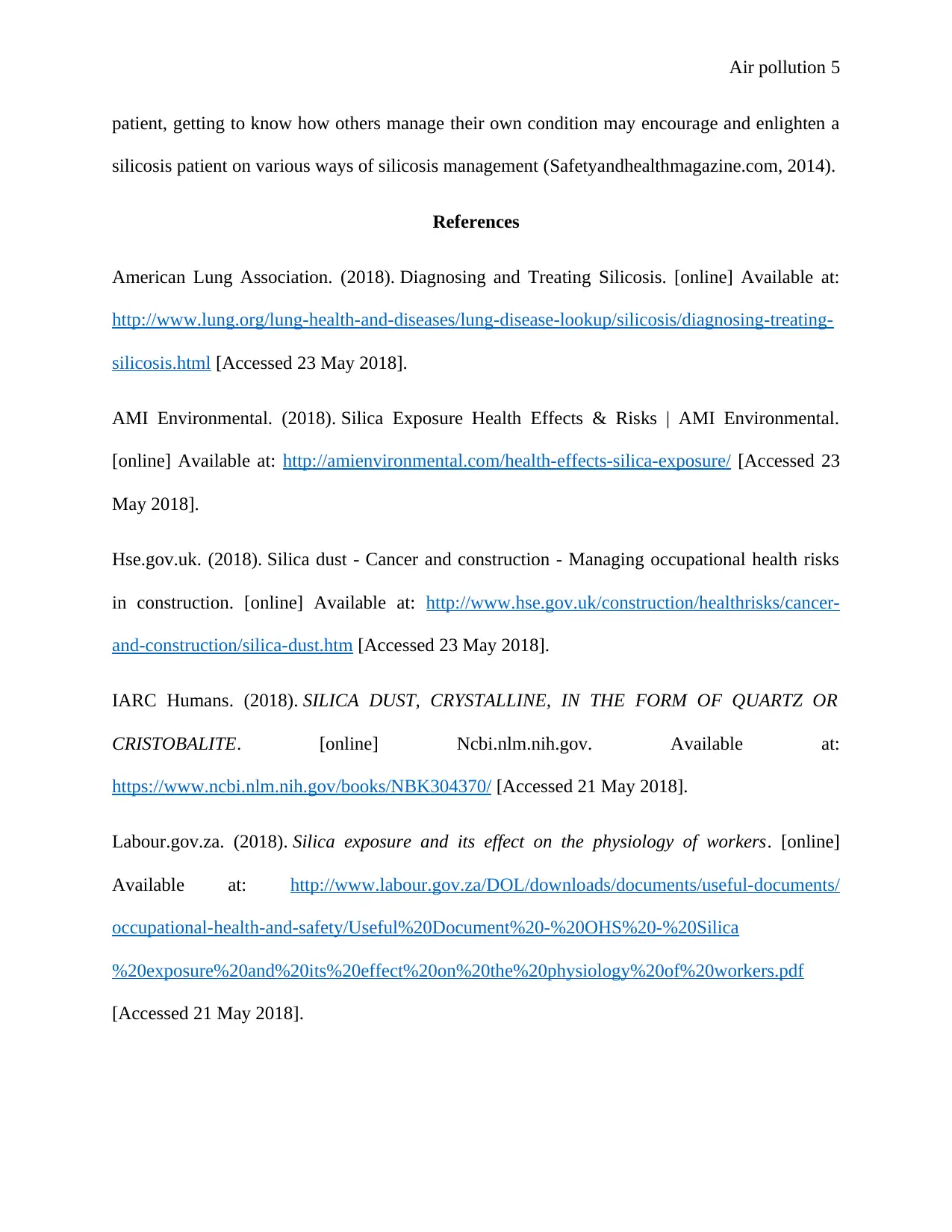
Air pollution 5
patient, getting to know how others manage their own condition may encourage and enlighten a
silicosis patient on various ways of silicosis management (Safetyandhealthmagazine.com, 2014).
References
American Lung Association. (2018). Diagnosing and Treating Silicosis. [online] Available at:
http://www.lung.org/lung-health-and-diseases/lung-disease-lookup/silicosis/diagnosing-treating-
silicosis.html [Accessed 23 May 2018].
AMI Environmental. (2018). Silica Exposure Health Effects & Risks | AMI Environmental.
[online] Available at: http://amienvironmental.com/health-effects-silica-exposure/ [Accessed 23
May 2018].
Hse.gov.uk. (2018). Silica dust - Cancer and construction - Managing occupational health risks
in construction. [online] Available at: http://www.hse.gov.uk/construction/healthrisks/cancer-
and-construction/silica-dust.htm [Accessed 23 May 2018].
IARC Humans. (2018). SILICA DUST, CRYSTALLINE, IN THE FORM OF QUARTZ OR
CRISTOBALITE. [online] Ncbi.nlm.nih.gov. Available at:
https://www.ncbi.nlm.nih.gov/books/NBK304370/ [Accessed 21 May 2018].
Labour.gov.za. (2018). Silica exposure and its effect on the physiology of workers. [online]
Available at: http://www.labour.gov.za/DOL/downloads/documents/useful-documents/
occupational-health-and-safety/Useful%20Document%20-%20OHS%20-%20Silica
%20exposure%20and%20its%20effect%20on%20the%20physiology%20of%20workers.pdf
[Accessed 21 May 2018].
patient, getting to know how others manage their own condition may encourage and enlighten a
silicosis patient on various ways of silicosis management (Safetyandhealthmagazine.com, 2014).
References
American Lung Association. (2018). Diagnosing and Treating Silicosis. [online] Available at:
http://www.lung.org/lung-health-and-diseases/lung-disease-lookup/silicosis/diagnosing-treating-
silicosis.html [Accessed 23 May 2018].
AMI Environmental. (2018). Silica Exposure Health Effects & Risks | AMI Environmental.
[online] Available at: http://amienvironmental.com/health-effects-silica-exposure/ [Accessed 23
May 2018].
Hse.gov.uk. (2018). Silica dust - Cancer and construction - Managing occupational health risks
in construction. [online] Available at: http://www.hse.gov.uk/construction/healthrisks/cancer-
and-construction/silica-dust.htm [Accessed 23 May 2018].
IARC Humans. (2018). SILICA DUST, CRYSTALLINE, IN THE FORM OF QUARTZ OR
CRISTOBALITE. [online] Ncbi.nlm.nih.gov. Available at:
https://www.ncbi.nlm.nih.gov/books/NBK304370/ [Accessed 21 May 2018].
Labour.gov.za. (2018). Silica exposure and its effect on the physiology of workers. [online]
Available at: http://www.labour.gov.za/DOL/downloads/documents/useful-documents/
occupational-health-and-safety/Useful%20Document%20-%20OHS%20-%20Silica
%20exposure%20and%20its%20effect%20on%20the%20physiology%20of%20workers.pdf
[Accessed 21 May 2018].
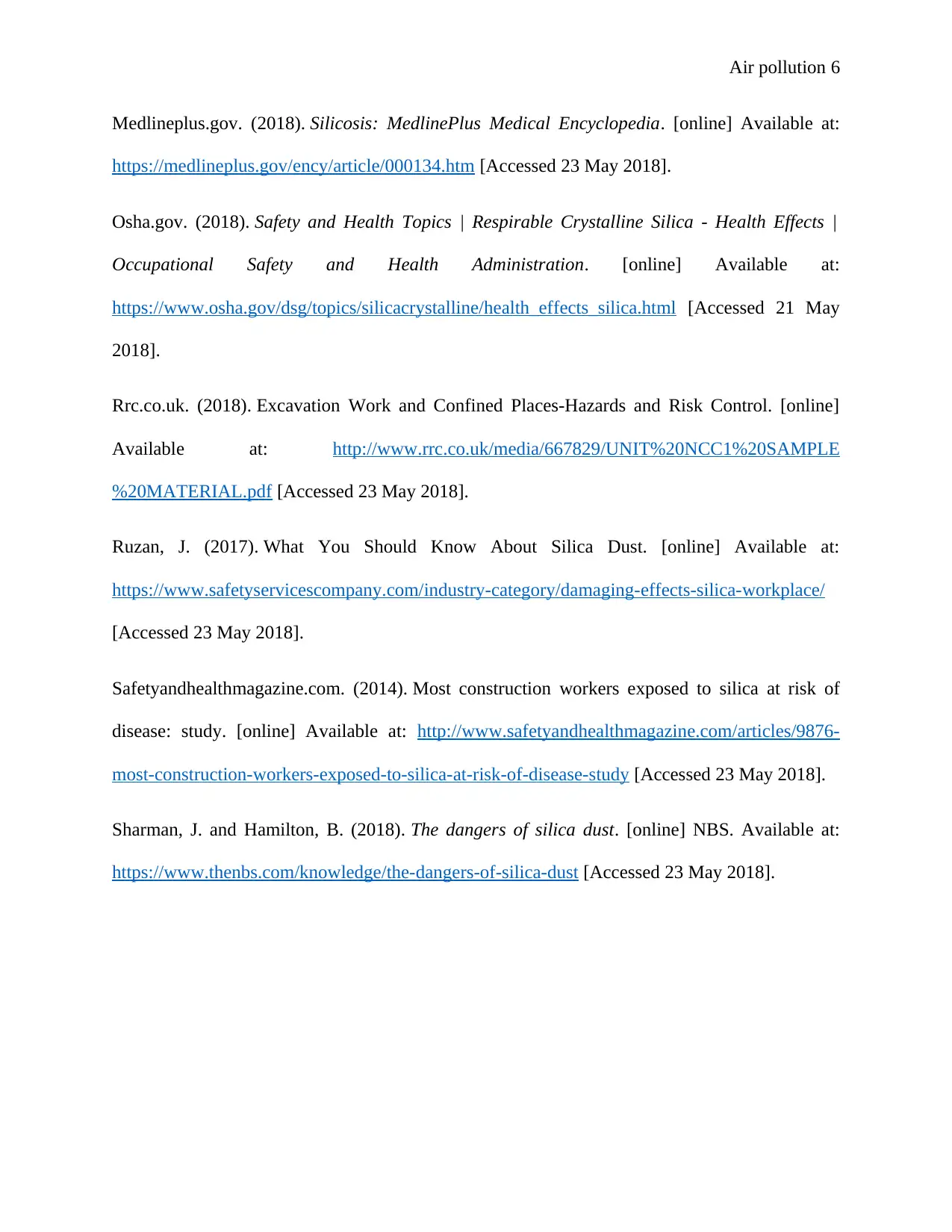
Air pollution 6
Medlineplus.gov. (2018). Silicosis: MedlinePlus Medical Encyclopedia. [online] Available at:
https://medlineplus.gov/ency/article/000134.htm [Accessed 23 May 2018].
Osha.gov. (2018). Safety and Health Topics | Respirable Crystalline Silica - Health Effects |
Occupational Safety and Health Administration. [online] Available at:
https://www.osha.gov/dsg/topics/silicacrystalline/health_effects_silica.html [Accessed 21 May
2018].
Rrc.co.uk. (2018). Excavation Work and Confined Places-Hazards and Risk Control. [online]
Available at: http://www.rrc.co.uk/media/667829/UNIT%20NCC1%20SAMPLE
%20MATERIAL.pdf [Accessed 23 May 2018].
Ruzan, J. (2017). What You Should Know About Silica Dust. [online] Available at:
https://www.safetyservicescompany.com/industry-category/damaging-effects-silica-workplace/
[Accessed 23 May 2018].
Safetyandhealthmagazine.com. (2014). Most construction workers exposed to silica at risk of
disease: study. [online] Available at: http://www.safetyandhealthmagazine.com/articles/9876-
most-construction-workers-exposed-to-silica-at-risk-of-disease-study [Accessed 23 May 2018].
Sharman, J. and Hamilton, B. (2018). The dangers of silica dust. [online] NBS. Available at:
https://www.thenbs.com/knowledge/the-dangers-of-silica-dust [Accessed 23 May 2018].
Medlineplus.gov. (2018). Silicosis: MedlinePlus Medical Encyclopedia. [online] Available at:
https://medlineplus.gov/ency/article/000134.htm [Accessed 23 May 2018].
Osha.gov. (2018). Safety and Health Topics | Respirable Crystalline Silica - Health Effects |
Occupational Safety and Health Administration. [online] Available at:
https://www.osha.gov/dsg/topics/silicacrystalline/health_effects_silica.html [Accessed 21 May
2018].
Rrc.co.uk. (2018). Excavation Work and Confined Places-Hazards and Risk Control. [online]
Available at: http://www.rrc.co.uk/media/667829/UNIT%20NCC1%20SAMPLE
%20MATERIAL.pdf [Accessed 23 May 2018].
Ruzan, J. (2017). What You Should Know About Silica Dust. [online] Available at:
https://www.safetyservicescompany.com/industry-category/damaging-effects-silica-workplace/
[Accessed 23 May 2018].
Safetyandhealthmagazine.com. (2014). Most construction workers exposed to silica at risk of
disease: study. [online] Available at: http://www.safetyandhealthmagazine.com/articles/9876-
most-construction-workers-exposed-to-silica-at-risk-of-disease-study [Accessed 23 May 2018].
Sharman, J. and Hamilton, B. (2018). The dangers of silica dust. [online] NBS. Available at:
https://www.thenbs.com/knowledge/the-dangers-of-silica-dust [Accessed 23 May 2018].
⊘ This is a preview!⊘
Do you want full access?
Subscribe today to unlock all pages.

Trusted by 1+ million students worldwide
1 out of 6
Related Documents
Your All-in-One AI-Powered Toolkit for Academic Success.
+13062052269
info@desklib.com
Available 24*7 on WhatsApp / Email
![[object Object]](/_next/static/media/star-bottom.7253800d.svg)
Unlock your academic potential
Copyright © 2020–2025 A2Z Services. All Rights Reserved. Developed and managed by ZUCOL.




